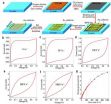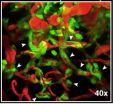(Press-News.org) The rapid development of miniaturized portable electronic devices, such as micro-electromechanical systems, microrobots and implantable medical devices, has stimulated intense demand for micro-scale power sources. Although miniaturized micro-batteries that store energy by redox reactions provide the most frequently used micro-power source for current portable electronics on chip, their limited lifetime (hundreds or thousands of cycles) and low power density rule out applications that require high power over a short timeframe.
Micro-supercapacitors (MSCs) with a short ion diffusion distance are newly emerging miniaturized high-power microelectrochemical energy-storage devices that can deliver high power density, fast charge and discharge, and a superior cycling lifetime (millions of cycles). MSCs possess great potential for flexible and on-chip portable and self-powered operation.
Graphene has been demonstrated to be a very promising candidate for constructing high-performance and flexible MSCs due to its unique structural features and physical properties, e.g., large surface area, high intrinsic areal capacitance and gravimetric capacitance. Graphene-based MSCs can fully utilize the planar geometry and advantageous features of graphene for on-chip energy storage. Planar MSCs that allow electrolyte ions to rapidly interact with all graphene layers in the horizontal direction are superior to conventional sandwich-like stacked devices.
In a new overview published in the Beijing-based National Science Review, scientists at the Max Planck Institute for Polymer Research in Mainz, Germany, and at the Shenyang National Laboratory for Materials Science in Shenyang, China present the latest advances in on-chip graphene-based planar interdigital MSCs. Co-authors Zhong-Shuai Wu, Xinliang Feng and Hui-Ming Cheng trace the history of the development of supercapacitors; they also review representative graphene-based materials (graphene sheets, graphene quantum dots and graphene hybrids) used to manufacture MSCs, typical microfabrication strategies (photolithography techniques, electrochemical methods, laser writing), electrolytes (aqueous, organic, ionic and gel), and device configurations (symmetric and asymmetric).
These scientists likewise outline the potential development directions of future graphene-based MSCs.
"Traditionally, a supercapacitor is composed of two collectors, two electrodes, a separator and an electrolyte, and the cell is assembled into a sandwich-like stacked configuration of a collector/electrode/separator/electrode/collector and is surrounded with sealing and packaging materials," they state in an article titled "Recent advances in graphene-based planar micro-supercapacitors for on-chip energy storage."
"The electrolyte mostly consists of a conductive liquid mixture of an aqueous or organic solvent that can migrate into and out of the two electrodes during the charge and discharge process," they add. "The two electrodes are mechanically separated by an ion-permeable membrane that serves as a separator between the two electrodes to prevent a short circuit. The metallic collectors electrically connect the electrodes as the input/output terminals of electricity to an outside circuit."
The first prototype planar MSCs built with a liquid electrolyte on a silicon substrate in 2003 gave way to later optimized construction of all-solid-state and flexible MSCs, and then to the state-of-the-art, carbon-based MSCs.
Advances have included graphene-based planar interdigital MSCs that were based on methane plasma reduced graphene films micropatterned on arbitrary substrates. "These microdevices allow operation at ultrahigh rates up to 1000 V s−1, three orders of magnitude higher than conventional supercapacitors, highlighting the superiority of the planar device geometry over the classical sandwich-like stack geometry for supercapacitors," they state.
"Further improvement in the performance of graphene-based MSCs can be achieved through the reasonable optimization of the composition of the active electrode materials, thin-film manufacturing techniques, interfacial integrity of the main components (electrode, separator, electrolyte and substrate) and micro-electrode design, as well as the selection of the electrolytes," the scientists forecast.
"The current advancement of graphene-based MSCs should address the urgent need for micro-scale energy storage," they add. "Graphene-based MSCs promise ultrahigh energy and power micro-electrochemical energy-storage devices that are able to offer enough energy and satisfy the peak power required for a great number of applications in miniaturized electronic devices."
INFORMATION:
This research received funding from the European Research Council and the German Research Foundation, the National Natural Science Foundation of China, the Ministry of Science and Technology of China, and the Chinese Academy of Sciences.
See the article:
Zhong-Shuai Wu, Xinliang Feng, and Hui-Ming Cheng
Recent advances in graphene-based planar micro-supercapacitors for on-chip energy storage
Natl Sci Rev (June 2014) 1 (2): 277-292
http://nsr.oxfordjournals.org/content/1/2/277.full
The National Science Review is the first comprehensive scholarly journal released in English in China that is aimed at linking the country's rapidly advancing community of scientists with the global frontiers of science and technology. The journal also aims to shine a worldwide spotlight on scientific research advances across China.
Graphene-based planar micro-supercapacitors for on-chip energy storage
2014-08-12
ELSE PRESS RELEASES FROM THIS DATE:
Researchers prove stability of wonder material silicene
2014-08-12
An international team of researchers has taken a significant step towards understanding the fundamental properties of the two-dimensional material silicene by showing that it can remain stable in the presence of oxygen.
In a study published today, 12 August, in IOP Publishing's journal 2D Materials, the researchers have shown that thick, multilayers of silicene can be isolated from its parent material silicon and remain intact when exposed to air for at least 24 hours.
It is the first time that such a feat has been achieved and will allow scientists to further probe ...
Prognosis of pneumonia: value of respiratory rate often overlooked
2014-08-12
Pneumonia – a severe lung infection – is the most common disease calling for hospital admission. More than one out of ten pneumonia patients die of the disease. Thus it is vital to accurately predict and closely monitor the clinical course. Here, measuring the respiratory rate – the number of breaths a person takes in a minute – provides valuable information. However, far too little use is still being made of this vital sign in clinical practice, as Richard Strauß and co-authors conclude in their recent study in Deutsches Ärzteblatt (Dtsch Arztebl Int 2014; 111: 503).
The ...
Hijacking the brain's blood supply: tumor discovery could aid treatment
2014-08-12
ANN ARBOR, Mich. — Dangerous brain tumors hijack the brain's existing blood supply throughout their progression, by growing only within narrow potential spaces between and along the brain's thousands of small blood vessels, new research shows for the first time.
The findings contradict the concept that brain tumors need to grow their own blood vessels to keep themselves growing – and help explain why drugs that aim to stop growth of the new blood vessels have failed in clinical trials to extend the lives of patients with the worst brain tumors.
In fact, trying to ...
Lead released from African cookware contaminates food
2014-08-12
San Francisco and Yaoundé – Lead levels in foods prepared in aluminum pots from Cameroon exceed U.S. guidelines for lead consumption according to a new study published this month. A typical serving contains almost 200 times more lead than California's Maximum Allowable Dose Level (MADL) of 0.5 micrograms per day.
Researchers at Ashland University and Occupational Knowledge International tested 29 samples of aluminum cookware made in Cameroon and found almost all had considerable lead content. This cookware is common throughout Africa and Asia and is made from recycled ...
Changes in motor function in the unaffected hand of stroke patients should not be ignored
2014-08-12
With effective rehabilitation, stroke patients can partially regain their motor control and continue their activities of daily living. Motor function changes in the unaffected hand of stroke patients with hemiplegia. However, these changes are often ignored by clinicians owing to the extent of motor disability of the affected hand. Research group at Shanghai University of Sport, China led by Prof. Zhusheng Yu based on finger tapping frequency and Lind-mark hand function score have found that the motor function of unaffected hands in stroke patients was poorer than that ...
Neuroprotective effect of tongxinluo: a PET imaging study in small animals
2014-08-12
Tongxinluo has been widely used in China for the treatment of acute stroke and for neuroprotection. Research group at Encephalopathy Center, Guangdong Provincial Hospital of Traditional Chinese Medicine, China intragastrically administered Tongxinluo superfine powder suspension or its vehicle to rats for 5 successive days before middle cerebral artery occlusion. There are many advantages of using small animal PET for drug research. First, the results of the study in vitro cannot be directly applied to human studies, while small animal PET imaging methods and results can ...
ASU-Mayo researchers use calcium isotope analysis to predict myeloma progression
2014-08-12
TEMPE, Ariz. – A team of researchers from Arizona State University and Mayo Clinic is showing how a staple of Earth science research can be used in biomedical settings to predict the course of disease.
The researchers tested a new approach to detecting bone loss in cancer patients by using calcium isotope analysis to predict whether myeloma patients are at risk for developing bone lesions, a hallmark of the disease.
They believe they have a promising technique that could be used to chart the progression of multiple myeloma, a lethal disease that eventually impacts ...
Neutrino detectors could help curb nuclear weapons activity
2014-08-12
Physicists at the Large Hadron Collider in Switzerland and even in the fictional world of CBS' "The Big Bang Theory" look to subatomic particles called neutrinos to answer the big questions about the universe.
Now, a group of scientists led by a physics professor with the College of Science at Virginia Tech are asking whether the neutrino could provide the world with clues about nuclear proliferation in Iran and other political hotspots.
Neutrinos are produced by the decay of radioactive elements, and nuclear reactors produce large amounts of neutrinos that cannot ...
Focal blood-brain-barrier disruption with high-frequency pulsed electric fields
2014-08-12
A team of researchers from the Virginia Tech-Wake Forest University School of Biomedical Engineering and Sciences have developed a new way of using electricity to open the blood-brain-barrier (BBB). The Vascular Enabled Integrated Nanosecond pulse (VEIN pulse) procedure consists of inserting minimally invasive needle electrodes into the diseased tissue and applying multiple bursts of nanosecond pulses with alternating polarity. It is thought that the bursts disrupt tight junction proteins responsible for maintaining the integrity of the BBB without causing damage to the ...
A highly sensitive microsphere-based assay for early detection of Type I diabetes
2014-08-12
A team of researchers from the Center for Engineering in Medicine at the Massachusetts General Hospital have developed a novel fluorescence-based assay for sensitive detection of antibodies within microliter volume serum samples. This new assay is at least 50 times more sensitive than the traditional radioimmunoassay (RIA), which is the gold standard currently used in the clinic. This new technology is particularly attractive for immunological assays as it allows: 1) use of very small volumes of sample reagents (5 ¦ÌL), and 2) use of traditional analytical systems such ...




